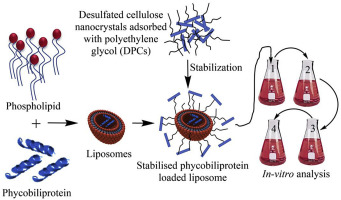当前位置:
X-MOL 学术
›
Food Hydrocoll.
›
论文详情
Our official English website, www.x-mol.net, welcomes your
feedback! (Note: you will need to create a separate account there.)
Steric stabilization of phycobiliprotein loaded liposome through polyethylene glycol adsorbed cellulose nanocrystals and their impact on the gastrointestinal tract.
Food Hydrocolloids ( IF 11.0 ) Pub Date : 2020-01-01 , DOI: 10.1016/j.foodhyd.2019.105252 Avinash Singh Patel , SuriyaPrakaash Lakshmibalasubramaniam , Balunkeswar Nayak
Food Hydrocolloids ( IF 11.0 ) Pub Date : 2020-01-01 , DOI: 10.1016/j.foodhyd.2019.105252 Avinash Singh Patel , SuriyaPrakaash Lakshmibalasubramaniam , Balunkeswar Nayak

|
Abstract The goal of the study was to encapsulate phycobiliprotein (PBP), a seaweed bioactive compound with the help of liposome and stabilized through polyethylene glycol adsorbed cellulose nanocrystals (CNC). The study investigated the stability of CNC coating and the release of PBP compounds using a simulated human gastrointestinal tract (GIT) model. Adsorption of polyethylene glycol (PEG) with molecular weights of 400–4000 gmol-1 on desulfated CNCs (DCs) did not show any significant stability of liposomes during in-vitro GIT experiments. The effect of GIT phase on the quality characteristics of the sample revealed that the simulated gastric juice phase of GIT helps on desorption of polyethylene glycol from desulfated CNCs surface followed by precipitation of DCs. This phenomena confirmed the effective agglomeration of liposomes in the gastric phase of the GIT. The liposomes stabilized through the higher molecular weight of PEG adsorbed with DCs (i.e., DPCs-4000, DPCs-1500, and DPCs-1000) displayed a higher degree of anti-agglomeration behavior as compared to the lower molecular weight of PEG with desulfated CNCs (DPCs-600 and DPCs-400). However, liposomes stabilized through pure DCs displayed insignificant (p > 0.05) effect on the stability of PBP loaded liposomes. We concluded that the adsorption of PEG onto DCs surface was enough to stabilize PBP loaded liposomes in a mouth and saliva environment. This finding is relevant to understand the stability of CNC as coating material and PBP as core bioactive compounds in the human digestive system for potential nutraceutical and food applications.
中文翻译:

通过聚乙二醇吸附的纤维素纳米晶体对负载藻胆蛋白的脂质体进行空间稳定及其对胃肠道的影响。
摘要 本研究的目的是在脂质体的帮助下封装藻胆蛋白 (PBP),这是一种海藻生物活性化合物,并通过聚乙二醇吸附的纤维素纳米晶体 (CNC) 稳定。该研究使用模拟人胃肠道 (GIT) 模型研究了 CNC 涂层的稳定性和 PBP 化合物的释放。在体外 GIT 实验期间,在脱硫 CNCs (DCs) 上吸附分子量为 400–4000 gmol-1 的聚乙二醇 (PEG) 并未显示脂质体的任何显着稳定性。GIT 相对样品质量特性的影响表明,GIT 的模拟胃液相有助于聚乙二醇从脱硫的 CNCs 表面解吸,随后 DCs 沉淀。这种现象证实了脂质体在 GIT 胃相中的有效聚集。与具有脱硫 CNCs 的较低分子量 PEG 相比,通过吸附有 DCs(即 DPCs-4000、DPCs-1500 和 DPCs-1000)的较高分子量 PEG 稳定的脂质体显示出更高程度的抗团聚行为(DPCs-600 和 DPCs-400)。然而,通过纯 DC 稳定的脂质体对负载 PBP 的脂质体的稳定性没有显着影响(p > 0.05)。我们得出结论,PEG 吸附到 DCs 表面足以稳定口腔和唾液环境中的 PBP 脂质体。这一发现与了解 CNC 作为涂层材料和 PBP 作为人类消化系统中核心生物活性化合物的稳定性有关,可用于潜在的营养食品和食品应用。
更新日期:2020-01-01
中文翻译:

通过聚乙二醇吸附的纤维素纳米晶体对负载藻胆蛋白的脂质体进行空间稳定及其对胃肠道的影响。
摘要 本研究的目的是在脂质体的帮助下封装藻胆蛋白 (PBP),这是一种海藻生物活性化合物,并通过聚乙二醇吸附的纤维素纳米晶体 (CNC) 稳定。该研究使用模拟人胃肠道 (GIT) 模型研究了 CNC 涂层的稳定性和 PBP 化合物的释放。在体外 GIT 实验期间,在脱硫 CNCs (DCs) 上吸附分子量为 400–4000 gmol-1 的聚乙二醇 (PEG) 并未显示脂质体的任何显着稳定性。GIT 相对样品质量特性的影响表明,GIT 的模拟胃液相有助于聚乙二醇从脱硫的 CNCs 表面解吸,随后 DCs 沉淀。这种现象证实了脂质体在 GIT 胃相中的有效聚集。与具有脱硫 CNCs 的较低分子量 PEG 相比,通过吸附有 DCs(即 DPCs-4000、DPCs-1500 和 DPCs-1000)的较高分子量 PEG 稳定的脂质体显示出更高程度的抗团聚行为(DPCs-600 和 DPCs-400)。然而,通过纯 DC 稳定的脂质体对负载 PBP 的脂质体的稳定性没有显着影响(p > 0.05)。我们得出结论,PEG 吸附到 DCs 表面足以稳定口腔和唾液环境中的 PBP 脂质体。这一发现与了解 CNC 作为涂层材料和 PBP 作为人类消化系统中核心生物活性化合物的稳定性有关,可用于潜在的营养食品和食品应用。































 京公网安备 11010802027423号
京公网安备 11010802027423号